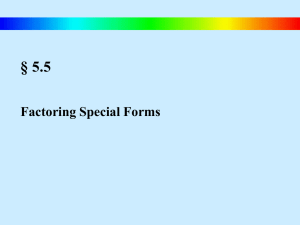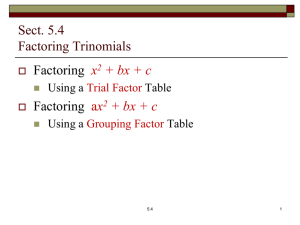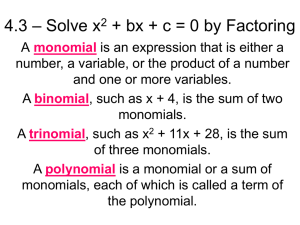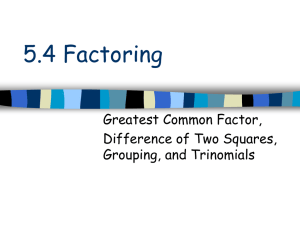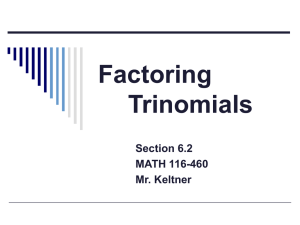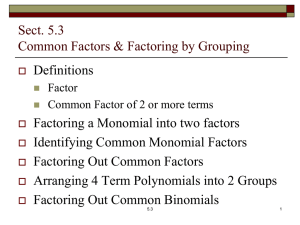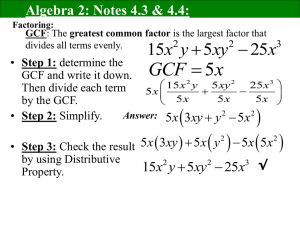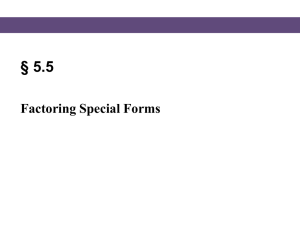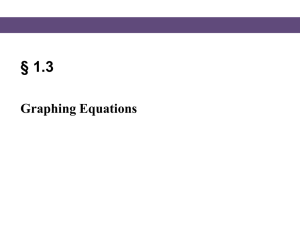Chapter Five 5.3
advertisement
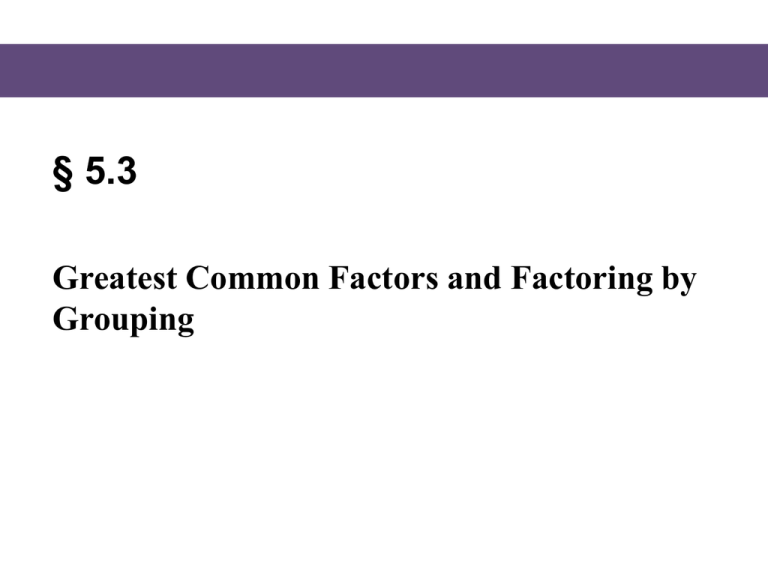
§ 5.3 Greatest Common Factors and Factoring by Grouping Factoring Factoring a polynomial means finding an equivalent expression that is a product. For example, when we take the polynomial 3a 2 x 6a 2 y 2bx 4by And write it as x 2 y 3a 2 2b we say that we have factored the polynomial. In factoring, we write a sum as a product. Blitzer, Intermediate Algebra, 5e – Slide #2 Section 5.3 Factoring Factoring a Monomial from a Polynomial 1) Determine the greatest common factor of all terms in the polynomial. 2) Express each term as the product of the GCF and its other factor. 3) Use the distributive property to factor out the GCF. Blitzer, Intermediate Algebra, 5e – Slide #3 Section 5.3 Factoring EXAMPLE Factor: 49x 4 y3 z 5 70x3 y 5 z 4 35x 4 y 4 z 3 . SOLUTION First, we determine the greatest common factor of the three terms. 49x 4 y3 z 5 70x3 y5 z 4 35x4 y 4 z 3 Notice that the greatest integer that divides into 49, 70 and 35 (the coefficients of the terms) is 7. The variables raised to the smallest exponents are x3 , y3 and z 3 . The GCF is 7 x3 y 3 z 3 . Blitzer, Intermediate Algebra, 5e – Slide #4 Section 5.3 P 332 Factoring CONTINUED 49x 4 y3 z 5 70x3 y5 z 4 35x 4 y 4 z 3 7 x3 y3 z 3 7 xz2 7 x3 y3 z 3 10y 2 z 7 x3 y3 z 3 5xy Express each term as the product of the GCF and its other factor 7 x3 y 3 z 3 7 xz2 10y 2 z 5xy Factor out the GCF P 332 Blitzer, Intermediate Algebra, 5e – Slide #5 Section 5.3 A Strategy for Factoring Polynomials, page 363 1. If there is a common factor, factor out the GCF or factor out a common factor with a negative coefficient. 2. Determine the number of terms in the polynomial and try factoring as follows: (a) If there are two terms, can the binomial be factored by using one of the following special forms. Difference of two squares: A2 B 2 A B A B /////////////////////////////////////////// Sum and Difference of two cubes: (b) If there are three terms, 2 2 2 A 2 AB B A B If is the trinomial a perfect square trinomial 2 A2 2 AB B2 A B use one of the adjacent forms: If the trinomial is not a perfect square trinomial, If a is equal to 1, use the trial and error If a is > than 1, use the grouping method (c) If there are four or more terms, try factoring by grouping. Blitzer, Intermediate Algebra, 5e – Slide #6 Section 5.6 Factoring EXAMPLE P 333 Factor: 5 x 3 50x 2 10x . SOLUTION The GCF is 5x. Because the leading coefficient, -5, is negative, we factor out a common factor with a negative coefficient. We will factor out the negative of the GCF, or -5x. 5x3 50x 2 10x 5x x2 5x10x 5x2 5x x 2 10x 2 Important to factor the negative sign Blitzer, Intermediate Algebra, 5e – Slide #7 Section 5.3 Express each term as the product of the GCF and its other factor Factor out the GCF Factoring Check Point 1 Factor 20x 30x 2 10x 10x2x 3 Check Point 2a Factor 9 x 21x 4 3x 2 3x2 3x2 7 2 P 332-333 Blitzer, Intermediate Algebra, 5e – Slide #8 Section 5.2 Factoring Check Point 2b 15x3 y 2 25x4 y3 Factor 5x3 y 2 5x y 3 - 5xy 3 2 Check Point 2c Factor 16x y 8x y 4 x y 4 5 3 4 2 3 2 3 4x y 4 x 2 y 3 4 x 2 y 2 2 xy 1 P 332-333 Blitzer, Intermediate Algebra, 5e – Slide #9 Section 5.2 Factoring Check Point 3 Factor 2 x3 10x 2 6 x - 2x - 2x x - 5x 3 2 Want a to be positive P 334 Blitzer, Intermediate Algebra, 5e – Slide #10 Section 5.2 Factoring by Grouping EXAMPLE Factor: 7 xx y x y . SOLUTION Let’s identify the common binomial factor in each part of the problem. 7 x x y x y The GCF, a binomial, is x + y. The GCF, a binomial, is x + y. P 334 Blitzer, Intermediate Algebra, 5e – Slide #11 Section 5.3 Factoring by Grouping CONTINUED We factor out the common binomial factor as follows. 7 x x y x y 7 xx y 1 x y x y 7 x 1 This step, usually omitted, shows each term as the product of the GCF and its other factor, in that order. Factor out the GCF Blitzer, Intermediate Algebra, 5e – Slide #12 Section 5.3 Factoring Check Point 4a Factor 3x 4 7ax 4 x - 4 x 43 7a Check Point 4b Factor 7 xa b a b a b a b7x -1 P 334 Blitzer, Intermediate Algebra, 5e – Slide #13 Section 5.2 Factoring by Grouping Factoring by Grouping 1) Group terms that have a common monomial factor. There will usually be two groups. Sometimes the terms must be rearranged. 2) Factor out the common monomial factor from each group. 3) Factor out the remaining common binomial factor (if one exists). P 334 Blitzer, Intermediate Algebra, 5e – Slide #14 Section 5.3 Factoring by Grouping EXAMPLE P 334 Factor: 3a 2 x 6a 2 y 2bx 4by . SOLUTION There is no factor other than 1 common to all terms. However, we can group terms that have a common factor: 3a 2 x 6a 2 y Common factor is : 3a 2 3a 2 x 6a 2 y 3a 2 x 2 y + 2bx 4by Use -2b, rather than 2b, as the common factor: -2bx – 4by = -2b(x + 2y). In this way, the common binomial factor, x + 2y, appears. Blitzer, Intermediate Algebra, 5e – Slide #15 Section 5.3 Factoring by Grouping CONTINUED P 334 The voice balloons illustrate that it is sometimes necessary to use a factor with a negative coefficient to obtain a common binomial factor for the two groupings. We now factor the given polynomial as follows: 3a 2 x 6a 2 y 2bx 4by 3a 2 x 6a 2 y 2bx 4by 3a 2 x 2 y 2bx 2 y x 2 y 3a 2 2b Group terms with common factors Factor out the common factors from the grouped terms Factor out the GCF Blitzer, Intermediate Algebra, 5e – Slide #16 Section 5.3 Factoring Check Point 5 Factor x 3 4 x 2 5 x 20 x 4x 2 5 Check Point 6 Factor 4x2 20x 3xy 15y x 54x - 3y P 335-6 Blitzer, Intermediate Algebra, 5e – Slide #17 Section 5.2 DONE Factoring by Grouping EXAMPLE Your local electronics store is having an end-of-the-year sale. The price on a large-screen television had been reduced by 30%. Now the sale price is reduced by another 30%. If x is the television’s original price, the sale price can be represented by (x – 0.3x) – 0.3(x – 0.3x) (a) Factor out (x – 0.3x) from each term. Then simplify the resulting expression. (b) Use the simplified expression from part (a) to answer these questions. With a 30% reduction followed by a 30% reduction, is the television selling at 40% of its original price? If not, at what percentage of the original price is it selling? Blitzer, Intermediate Algebra, 5e – Slide #19 Section 5.3 Factoring by Grouping CONTINUED SOLUTION (a) (x – 0.3x) – 0.3(x – 0.3x) = 1(x – 0.3x) – 0.3(x – 0.3x) = (x – 0.3x)(1 – 0.3) = (x – 0.3x)(0.7) This step, usually omitted, shows each term as the product of the GCF and its other factor, in that order. Factor out the GCF Subtract = 0.7x – 0.21x = 0.49x Distribute Subtract Blitzer, Intermediate Algebra, 5e – Slide #20 Section 5.3 Factoring by Grouping CONTINUED (b) With a 30% reduction, followed by another 30% reduction, the expression that represents the reduced price of the television simplifies to 0.49x. Therefore, this series of price reductions effectively gives a new price for the television at 49% its original price, not 40%. Blitzer, Intermediate Algebra, 5e – Slide #21 Section 5.3

